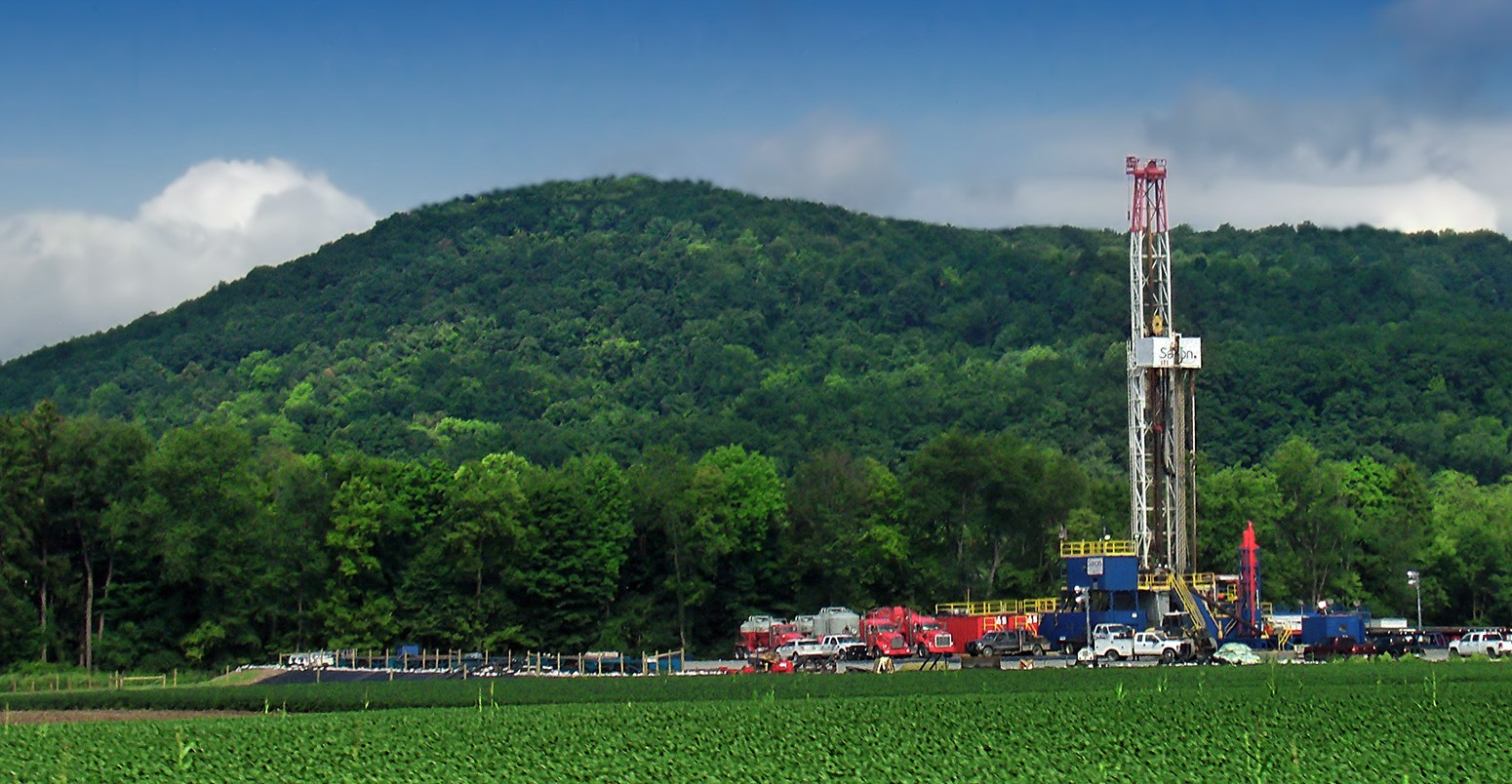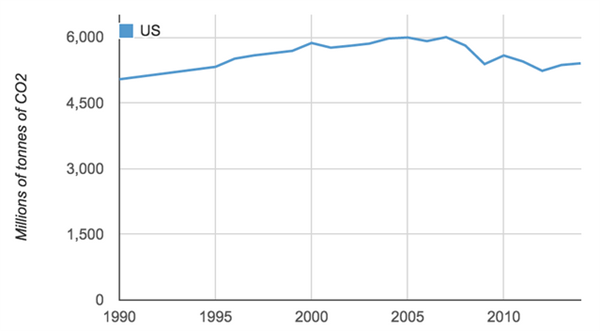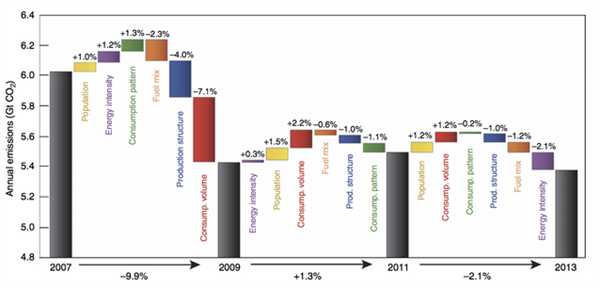
Recession rather than shale gas caused US carbon cuts – study
Simon Evans
07.21.15Simon Evans
21.07.2015 | 4:00pmIt is a truth almost universally acknowledged that the shale gas revolution has led to a fall in US emissions. But what if that wasn’t true?
New research published in Nature Communications suggests it was the global financial crisis, not fracking, that has done most to reduce carbon dioxide (CO2) emissions from the US.
The paper concludes:
“After 2007, decreasing emissions were largely a result of economic recession…substitution of gas for coal has had a relatively minor role.”
Carbon Brief looks at the findings, and why they could be politically significant.
Conventional wisdom
The idea that shale gas has been behind US emissions reductions is repeated in news coverage, speeches and reports. It is used by gas advocates making the case for fracking in the UK. It has entered the political consciousness and is widely accepted as fact.
This conventional wisdom runs to the highest levels of scientific analysis. In its latest assessment report the Intergovernmental Panel on Climate Change says fracking is “an important reason for a reduction of greenhouse gas emissions in the United States”.
In the US context, shale gas is seen as a key reason both for emissions reductions and in creating the political space necessary to take action on climate change.
One veteran of the Congressional climate and energy debate has told Carbon Brief that shale gas had changed the political conversation. During failed attempts to impose a national cap-and-trade scheme, the talk was of expensive overseas gas being imported to help limit emissions.
Now, the source said, almost all of the emissions reductions required to meet President Obama’s Clean Power Plan are expected to come from coal-to-gas switching, using cheap US shale gas.

Carbon dioxide emissions in the United States between 1990 and 2014. Total greenhouse gas emissions have followed a similar trend but available figures are less up to date. Source: US Energy Information Administration. Chart by Carbon Brief.
Sizing shale’s influence
Given this expectation, a lot is riding on whether or not shale gas really has reduced emissions. The relevance of fracking for emissions reductions has been challenged before. Yet while previous efforts have disagreed on the details, they have tended to assume a major role for shale.
The new research challenges this thinking head on. The authors say:
“Despite potentially significant implications for US climate and energy policy, there has been no quantitative analysis of whether the gas boom and changes in the fuel mix of the power sector are indeed driving the decrease in US CO2 emissions.”
Using an approach called structural decomposition analysis, the researchers attempt to break apart the factors behind changes in US emissions. The method is frequently applied at regional or national level to understand emissions trends. They use detailed sectoral data on energy use, intensity and economic activity to identify the most important reasons for shifts in CO2 emissions.
They consider: population growth; per-capita consumption; shifts in the types of goods and services people buy; structural shifts between services and manufacturing, as well as the quantity and type of goods used by industry; the amount of energy used per unit of wealth; and changes in the fuel mix.
The 10% cut in CO2 between 2007 and 2009 was “primarily the result of the economic recession”, the paper says. Falls in per capita consumption and changes in the structure of industry account for 83% of this (red and blue bars, below left), and fuel mix changes just 17% (orange).

Contributors to changing US CO2 emissions in three two-year periods covering 2007 to 2013. Source: Feng et al.
During the economic recovery, increases in population and rebounding consumption pushed emissions upwards. These were slightly outweighed by reductions due to fuel mix, production structure, consumption patterns and energy intensity (centre and right-hand areas, above).
Shale’s small impact
Significantly, in terms of which of these factors were most important, the paper says:
“Contrary to conventional wisdom, our decomposition analysis shows that changes in the fuel mix of the energy sector (including those related to the shale gas boom) account for a relatively small portion of this decrease.”
The rise of renewables, tightening air pollution standards and shale-driven reductions in gas prices saw coal’s share of the US power mix fall from 46% in 2009 to 39% in 2014. Gas recently topped coal as the top source of electricity for the first time.
Despite these profound shifts in the US power sector, today’s new research suggests other factors have been equally or more important in reducing emissions. It points, among other reasons, to falling oil use as cars became more efficient and the offshoring of emissions-intensive industries.
However, Mark S Brownstein, vice president at the Environmental Defense Fund’s climate & energy program, tells Carbon Brief that further study is required to better understand the specific impacts of the various factors at play:
“The methodology cannot be used to infer anything about the direct impacts of specific policies, such as power plant emissions limits or renewable portfolio standards, or the effect that changes in relative prices may have on fuel choice, such as the impact of the change in supply or price of natural gas or renewables may have had on the competitiveness of coal. Economic modeling would be required to discern these impacts.”
End of the gas bridge?
The study seems to undermine those that say shale gas has been good for the climate. Given the strength of support for shale gas in some quarters, however, it’s unlikely to pass unchallenged.
It’s also not the first time the natural gas bridge has been questioned. Increased coal exports and emissions in Europe have been blamed on the shale revolution. Others say it’s really renewables that are driving down coal use, or that gas has displaced renewables and nuclear, as well as coal.
On the other hand, US emissions might have increased without shale gas’s contribution to displacing coal, even if it hasn’t had as much to do with falling US emissions as previously thought.
So while today’s research is a challenge to conventional thinking on fracking’s climate impact, it will not end the argument for gas as a bridge from coal towards a lower-carbon future. Nor does it remove the need to think about what comes next. After all, gas, a fossil fuel, can have little place in the zero-carbon world to which the world’s leaders aspire.
Main image: Marcellus shale gas-drilling site, Pennsylvania.
Feng, K et al, 2015, Nature Communications, doi:10.1038/ncomms8714

